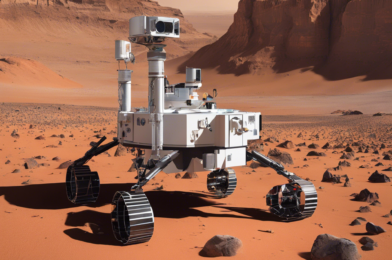**The Impact of Cosmic Ray Research in Unveiling the Mysteries of High-Energy Cosmic Processes**
Paragraph 1: Cosmic rays, highly energetic particles that continuously bombard Earth from space, have long captivated scientists eager to unlock the mysteries of the universe’s most powerful phenomena. Studying these rays offers a unique perspective on understanding the inner workings of the cosmos, including the inner mechanisms of supermassive black holes, distant supernovae, and the very origin of the universe. Indeed, cosmic rays serve as nature’s own “particle accelerators,” propelling particles to energies far beyond what human-made machines can achieve. Through dedicated research efforts, scientists are probing the universe’s highest-energy processes, pushing the boundaries of our knowledge.
Paragraph 2: One of the most intriguing aspects of cosmic ray research is their potential to reveal the inner workings of supermassive black holes. When matter falls into these cosmic behemoths, it can be accelerated to incredible speeds and energies, emitting intense radiation. By studying the patterns and characteristics of cosmic rays, researchers are able to gather insights into the feeding habits and inner engines of these gigantically dark entities. This provides a unique window into the extreme physics that governs the universe’s most massive and enigmatic objects.
Paragraph 3: Cosmic rays also carry invaluable information about distant supernovae, the explosive deaths of massive stars. Through the study of cosmic rays, researchers can decipher the intricate details of these powerful explosions, including the mechanisms that drive them and the chemical elements forged in their dying breaths. This field of study not only enhances our understanding of stellar evolution and the universe’s chemical enrichment but also provides a captivating glimpse into the dramatic finales of stars’ life cycles.
Paragraph 4: Furthermore, cosmic ray research contributes significantly to our comprehension of the very origins of the universe. The cosmic microwave background radiation, a faint remnant of the big bang, influences the propagation of cosmic rays. By meticulously studying this radiation, scientists can extract valuable clues about the early universe, including its composition, evolution, and the fundamental physics that governed its infancy. This renders cosmic ray research a potent tool in unravelling the mysteries of the universe’s first moments.
Paragraph 5: Beyond the insights they offer about celestial bodies and the early universe, cosmic rays also have a significant impact on our own planet. Their interactions with Earth’s magnetic field and atmosphere can produce breathtaking auroras, illuminating our night skies with vivid displays of light. Additionally, a deeper understanding of cosmic rays is crucial for space weather forecasting, helping us predict and mitigate potential impacts on satellite communications and electronic infrastructure.
Paragraph 6: The study of cosmic rays involves a multifaceted approach, utilizing both ground-based detectors and satellite-based observatories. Ground-based detectors, often situated in remote locations to avoid interference from Earth-born radiation, capture the telltale signatures of cosmic rays colliding with Earth’s atmosphere. Satellite-based observatories, on the other hand, directly detect cosmic rays in space, providing invaluable data on their composition and behavior.
Paragraph 7: One of the pioneering ground-based facilities in this field is the Pierre Auger Observatory, located in Argentina. Spread across an area larger than Singapore, this observatory employs a technique called the “air shower detection method.” When an extremely high-energy cosmic ray enters Earth’s atmosphere, it creates a cascade of particles akin to a shower, which the observatory detects and analyzes.
Paragraph 8: In addition to ground-based observatories, satellite-based missions play a crucial role in studying lower-energy cosmic rays. Examples include the Advanced Composition Explorer (ACE) and the Cosmic Ray Energetics And Mass (CREAM) experiment, both of which have made significant contributions to our understanding of cosmic ray composition and behavior. These missions provide unique opportunities to study cosmic rays directly in space, offering insights that complement those from ground-based observations.
Paragraph 9: Furthermore, cosmic ray research has profound implications for both astrophysics and particle physics. In astrophysics, it contributes to our understanding of the extreme environments surrounding black holes, neutron stars, and supernova remnants. Meanwhile, in particle physics, the study of ultra-high-energy cosmic rays has led to intriguing questions about fundamental particle properties and the potential existence of unknown exotic particles.
Paragraph 10: The impact of cosmic ray research extends beyond the realm of pure science, influencing technological advancements. For instance, the development of extensive cosmic ray observatories has driven innovations in detector technologies, data analysis techniques, and computational methods. This cross-disciplinary impact showcases the far-reaching benefits of investing in fundamental scientific research.
Paragraph 11: Moreover, the study of cosmic rays fosters international collaboration, bringing together scientists from diverse backgrounds and nationalities. This collaborative spirit not only accelerates scientific progress but also fosters cultural exchange and strengthens global connections. The pursuit of unraveling the universe’s mysteries through cosmic ray research exemplifies the power of international cooperation in advancing human knowledge.
Paragraph 12: In conclusion, cosmic ray research stands as a critical bridge connecting us to the cosmos, offering a unique means to explore the universe’s highest-energy processes. By studying these energetic particles, researchers are pushing the boundaries of human understanding, revealing the inner workings of supermassive black holes, distant supernovae, and the origins of the universe itself. As technology advances and our observational capabilities expand, the field of cosmic ray research promises to continue yielding fascinating insights, enriching our knowledge of the universe, and inspiring new generations of explorers eager to uncover the mysteries of the cosmos.





